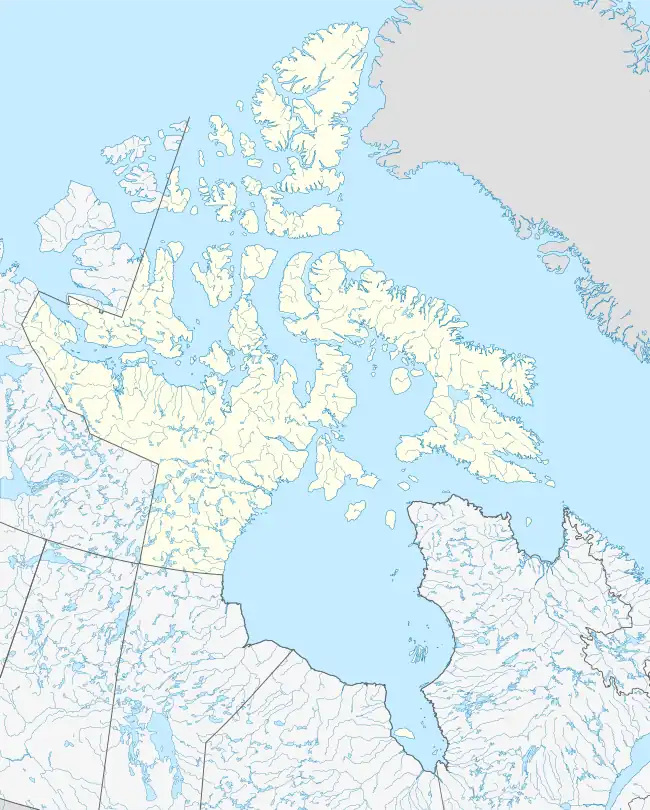Maittuq
Maittuq, formerly Anarnittuq Island, is a small uninhabited island, approximately 44 km (27 mi) south of Naujaat in the Kivalliq Region of Nunavut, Canada. It is located towards the north end of Roes Welcome Sound, just offshore of the Canadian mainland, where it meets Frozen Strait.
 Maittuq  Maittuq | |
| Geography | |
|---|---|
| Location | Roes Welcome Sound |
| Coordinates | 66°09′16″N 085°50′49″W[1] |
| Archipelago | Arctic Archipelago |
| Administration | |
Canada | |
| Territory | Nunavut |
| Region | Kivalliq |
| Demographics | |
| Population | Uninhabited |
| Ethnic groups | Inuit |
To the south lies Southampton Island and the community of Coral Harbour.
Climate
Naujaat t0 the north has a tundra climate (Köppen ET) with short but cool summers and long, cold winters.
| Climate data for Naujaat (Naujaat Airport) Climate ID: 2403490 ; coordinates 66°31′17″N 86°13′29″W; elevation: 22.9 m (75 ft); 1981–2010 normals | |||||||||||||
|---|---|---|---|---|---|---|---|---|---|---|---|---|---|
| Month | Jan | Feb | Mar | Apr | May | Jun | Jul | Aug | Sep | Oct | Nov | Dec | Year |
| Record high humidex | −4.6 | −11.6 | −2.1 | 2.4 | 7.9 | 21.1 | 29.3 | 21.9 | 15.4 | 4.2 | 0.4 | −1.0 | 29.3 |
| Record high °C (°F) | −1.7 (28.9) |
−11.0 (12.2) |
−1.5 (29.3) |
3.5 (38.3) |
8.0 (46.4) |
22.5 (72.5) |
28.0 (82.4) |
22.0 (71.6) |
15.5 (59.9) |
4.0 (39.2) |
0.0 (32.0) |
1.1 (34.0) |
28.0 (82.4) |
| Average high °C (°F) | −28.2 (−18.8) |
−28.0 (−18.4) |
−22.4 (−8.3) |
−12.8 (9.0) |
−3.6 (25.5) |
6.2 (43.2) |
13.1 (55.6) |
10.3 (50.5) |
3.3 (37.9) |
−4.4 (24.1) |
−15.2 (4.6) |
−22.3 (−8.1) |
−8.7 (16.3) |
| Daily mean °C (°F) | −31.3 (−24.3) |
−31.4 (−24.5) |
−26.4 (−15.5) |
−17.1 (1.2) |
−6.9 (19.6) |
3.0 (37.4) |
8.8 (47.8) |
6.8 (44.2) |
0.9 (33.6) |
−7.3 (18.9) |
−18.8 (−1.8) |
−25.8 (−14.4) |
−12.1 (10.2) |
| Average low °C (°F) | −34.1 (−29.4) |
−34.6 (−30.3) |
−30.4 (−22.7) |
−21.4 (−6.5) |
−10.2 (13.6) |
−0.1 (31.8) |
4.4 (39.9) |
3.2 (37.8) |
−1.5 (29.3) |
−10.2 (13.6) |
−22.2 (−8.0) |
−29.3 (−20.7) |
−15.5 (4.1) |
| Record low °C (°F) | −47.8 (−54.0) |
−50.0 (−58.0) |
−45.0 (−49.0) |
−40.0 (−40.0) |
−27.0 (−16.6) |
−11.0 (12.2) |
−1.0 (30.2) |
−3.0 (26.6) |
−11.5 (11.3) |
−31.0 (−23.8) |
−42.0 (−43.6) |
−46.0 (−50.8) |
−50.0 (−58.0) |
| Record low wind chill | −66.3 | −63.7 | −59.5 | −49.7 | −30.2 | −18.7 | 0.0 | −8.3 | −18.1 | −41.1 | −50.1 | −59.2 | −66.3 |
| Average precipitation mm (inches) | 18.4 (0.72) |
14.8 (0.58) |
18.6 (0.73) |
24.3 (0.96) |
18.5 (0.73) |
28.9 (1.14) |
29.0 (1.14) |
46.4 (1.83) |
33.6 (1.32) |
28.2 (1.11) |
29.2 (1.15) |
21.4 (0.84) |
311.3 (12.26) |
| Average rainfall mm (inches) | 0.0 (0.0) |
0.0 (0.0) |
0.0 (0.0) |
0.4 (0.02) |
1.9 (0.07) |
23.3 (0.92) |
29.0 (1.14) |
46.1 (1.81) |
22.3 (0.88) |
0.8 (0.03) |
0.0 (0.0) |
0.0 (0.0) |
123.8 (4.87) |
| Average snowfall cm (inches) | 18.8 (7.4) |
19.1 (7.5) |
21.7 (8.5) |
27.7 (10.9) |
19.7 (7.8) |
5.5 (2.2) |
0.0 (0.0) |
0.3 (0.1) |
12.6 (5.0) |
32.6 (12.8) |
32.9 (13.0) |
24.6 (9.7) |
215.4 (84.8) |
| Average precipitation days (≥ 0.2 mm) | 10.3 | 6.7 | 11.0 | 9.9 | 9.4 | 8.4 | 9.6 | 11.8 | 11.1 | 13.7 | 11.3 | 10.3 | 123.4 |
| Average rainy days (≥ 0.2 mm) | 0.0 | 0.0 | 0.0 | 0.2 | 0.8 | 6.5 | 9.6 | 11.8 | 7.1 | 0.6 | 0.1 | 0.0 | 36.5 |
| Average snowy days (≥ 0.2 cm) | 10.2 | 7.3 | 11.6 | 10.7 | 9.2 | 2.3 | 0.0 | 0.2 | 4.8 | 13.1 | 11.8 | 10.5 | 91.6 |
| Average relative humidity (%) | 74.2 | 71.9 | 73.5 | 80.9 | 82.7 | 78.1 | 65.3 | 71.1 | 81.1 | 85.9 | 79.1 | 76.0 | 76.7 |
| Source: Environment and Climate Change Canada Canadian Climate Normals 1981–2010[3] | |||||||||||||
References
- "Maittuq". Geographical Names Data Base. Natural Resources Canada.
- "Maittuq". Geographical Names Data Base. Natural Resources Canada.
- "Repulse Bay A". Canadian Climate Normals 1981–2010. Environment and Climate Change Canada. Climate ID: 2403490. Retrieved 27 November 2013.
This article is issued from Wikipedia. The text is licensed under Creative Commons - Attribution - Sharealike. Additional terms may apply for the media files.